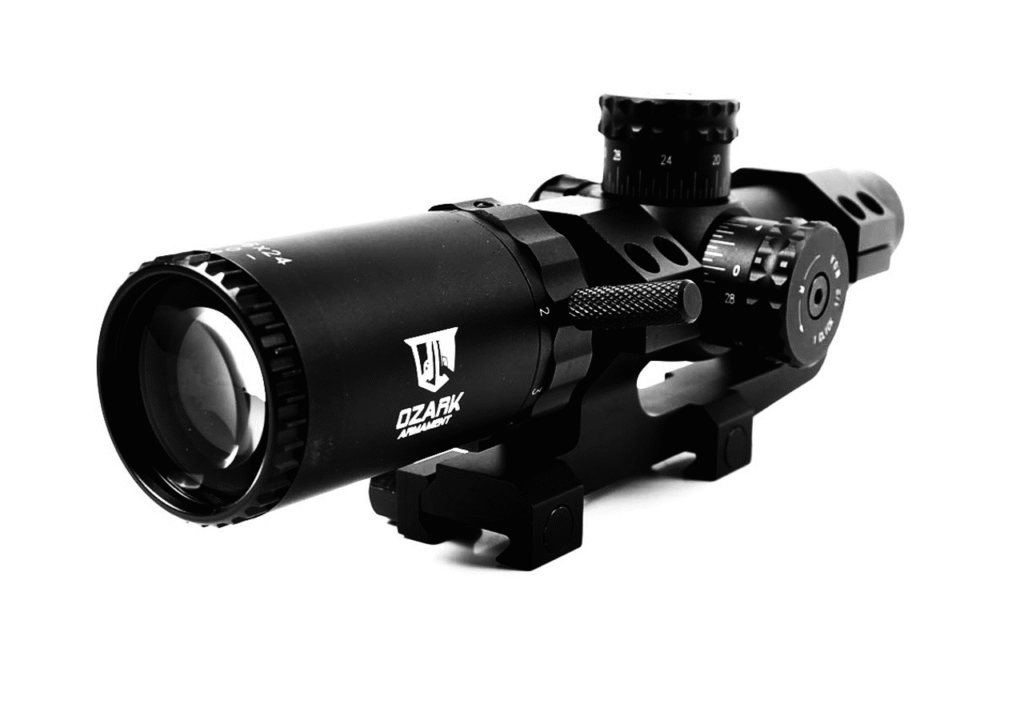Selecting the right optic for your AR-15 improves accuracy and shooting performance. This guide explains red dot sights versus magnified scopes, how to match optics to your shooting needs, what to consider at different price points, and how backup iron sights work with your primary optic.
Choosing the right optic determines how effectively you shoot your AR-15. Ozark Armament knows that AR-15 optics come in many types, and selecting the wrong one wastes money and hurts performance.
Red dots work best for close-range speed. Magnified scopes excel at distance. Your primary shooting activity determines which type serves you best.
This guide covers the main optic types, matches them to common shooting applications, explains budget considerations, and addresses how backup sights integrate with your primary optic.
Red Dots vs Magnified Scopes: Which AR-15 Optics Do You Need
AR-15 optics fall into two main categories. Red dot sights provide fast aiming at close to medium range. Magnified optics give you precision at a distance.
Red dot sights project an illuminated dot onto a lens. You aim by placing the dot on your target. These sights let you shoot with both eyes open, which maintains situational awareness. The dot stays aligned with your bore regardless of eye position. Most use a 2 MOA dot size that provides precision without covering your target.
Red dots excel from 0 to 100 yards. They’re lightweight and simple to use. Battery-powered illumination works in any light. The unlimited eye relief means you acquire targets fast from any shooting position.
Magnified optics use lenses to enlarge distant targets. Variable scopes like 1-6x or 3-9x let you adjust magnification. Low-power variable optics (LPVO) work from close range to 300 yards. Traditional hunting scopes in the 3-9x range handle longer distances.
Magnification helps you identify targets clearly and place precise shots beyond 100 yards. Variable power adapts to different ranges. At 1x, an LPVO functions almost like a red dot. Dial up to 6x and you can engage targets at 300 yards with accuracy.
Matching Optics to Home Defense, Hunting, and Range Shooting
Your shooting application tells you which optic type works best. Home defense needs different features than hunting or competition.
For home defense and close quarters, red dot sights provide the fastest target acquisition. Large sight windows help you find targets under stress. Illuminated reticles work in darkness. Simple aiming points reduce thinking during emergencies.
Key home defense optic features:
- Both eyes open, shooting maintains awareness of surroundings
- Always-on models eliminate fumbling with switches
- Long battery life ensures reliability when needed
- Durable construction survives bumps and impacts
- Clear sight picture in low light conditions
For hunting and long-range shooting, magnification becomes necessary. You need to identify the game clearly before shooting and place precise shots at a distance.
Distance shooting requires these optical features:
- Variable magnification adapts from 50 to 300 yards
- Clear glass helps during dawn and dusk hours
- Reticle options assist with bullet drop at various ranges
- Proper eye relief provides a comfortable shooting position
- Weather-resistant construction handles field conditions
An LPVO in the 1-6x range handles most hunting scenarios. Set it low when moving through cover, then dial up magnification for longer shots. Traditional 3-9x scopes work better for dedicated long-range shooting beyond 300 yards.
Budget Optics vs Premium: What Actually Matters for Performance
Quality optics exist at every price point. Understanding which features justify higher costs helps you spend wisely.
Budget optics deliver reliable performance when they include essential features. Look for aluminum construction, waterproof and shockproof ratings, and decent battery life. These basics ensure your optic survives normal field use. Check that it’s rated for 5.56 NATO recoil.
Many affordable red dots use solid aluminum housing and offer waterproof seals. Clear warranty coverage protects your purchase. Mount quality matters as much as the optic itself, so factor mounting costs into your budget.
Premium optics cost more but provide advantages for demanding use:
- Superior glass quality improves light transmission and clarity
- Better coatings deliver brighter sight pictures in low light
- Extreme durability handles professional or duty applications
- Lifetime warranties from established manufacturers
- Competition-grade features like larger windows and clearer glass
Premium optics shine in low-light conditions and provide reliability for professional use. If you depend on your rifle for duty or competition, the investment makes sense. Casual shooters often perform well with quality budget options that cover the fundamentals.
How Backup Iron Sights Work with Your Primary Optic
Backup sights provide redundancy if your optic fails. Understanding co-witness heights ensures proper integration.
Co-witness describes how your red dot aligns with iron sights. Absolute co-witness puts the dot directly on your iron sight posts. Lower 1/3 co-witness positions the dot higher, with iron sights visible in the lower portion of your sight window.
Lower 1/3 is popular because it keeps your sight picture cleaner while maintaining backup capability. Flip up your iron sights when needed, and the dot aligns above them.
Backup sight options include:
- Flip-up sights deploy quickly when your optic fails
- Offset sights at 45 degrees allow instant transition without optic removal
- Carry handle sights provide classic backup with an A2 sight picture
- Fixed sights stay ready, but can clutter your sight window
- Quality construction ensures they hold zero and survive impacts
Offset backup sights work well with magnified optics. Tilt your rifle 45 degrees, and you have immediate iron sight access for close targets without adjusting your scope.
Proper mount height ensures your optic co-witnesses correctly with your backup sights while maintaining a comfortable cheek weld. Test your setup to verify backup sights align properly before depending on the configuration.
Why Ozark Armament Backs Your AR-15 Optics with Quality Iron Sights
We understand that reliable AR-15 optics setups need quality backup iron sights. Ozark Armament manufactures flip-up sights, offset sights, and carry handles that integrate with your primary optic to keep you on target if electronics fail.
Our backup sights use durable aluminum construction and co-witness properly with standard optic mounting heights. Whether you run a red dot for home defense or an LPVO for hunting, our sights provide the redundancy serious shooters require.
Quality AR-15 optics deserve backup sights built to the same standards. We back every product with our NO B.S. Lifetime Warranty because backup sights must work when your primary optic doesn’t. Explore our complete line of iron sights and AR-15 optics accessories to build a setup you can trust.





